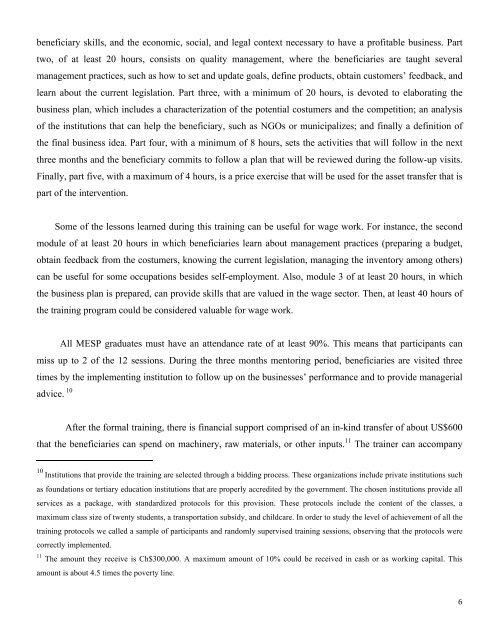DOCUMENTO
n?u=RePEc:ioe:doctra:461&r=lam
n?u=RePEc:ioe:doctra:461&r=lam
You also want an ePaper? Increase the reach of your titles
YUMPU automatically turns print PDFs into web optimized ePapers that Google loves.
eneficiary skills, and the economic, social, and legal context necessary to have a profitable business. Part<br />
two, of at least 20 hours, consists on quality management, where the beneficiaries are taught several<br />
management practices, such as how to set and update goals, define products, obtain customers’ feedback, and<br />
learn about the current legislation. Part three, with a minimum of 20 hours, is devoted to elaborating the<br />
business plan, which includes a characterization of the potential costumers and the competition; an analysis<br />
of the institutions that can help the beneficiary, such as NGOs or municipalizes; and finally a definition of<br />
the final business idea. Part four, with a minimum of 8 hours, sets the activities that will follow in the next<br />
three months and the beneficiary commits to follow a plan that will be reviewed during the follow-up visits.<br />
Finally, part five, with a maximum of 4 hours, is a price exercise that will be used for the asset transfer that is<br />
part of the intervention.<br />
Some of the lessons learned during this training can be useful for wage work. For instance, the second<br />
module of at least 20 hours in which beneficiaries learn about management practices (preparing a budget,<br />
obtain feedback from the costumers, knowing the current legislation, managing the inventory among others)<br />
can be useful for some occupations besides self-employment. Also, module 3 of at least 20 hours, in which<br />
the business plan is prepared, can provide skills that are valued in the wage sector. Then, at least 40 hours of<br />
the training program could be considered valuable for wage work.<br />
All MESP graduates must have an attendance rate of at least 90%. This means that participants can<br />
miss up to 2 of the 12 sessions. During the three months mentoring period, beneficiaries are visited three<br />
times by the implementing institution to follow up on the businesses’ performance and to provide managerial<br />
advice. 10<br />
After the formal training, there is financial support comprised of an in-kind transfer of about US$600<br />
that the beneficiaries can spend on machinery, raw materials, or other inputs. 11 The trainer can accompany<br />
10 Institutions that provide the training are selected through a bidding process. These organizations include private institutions such<br />
as foundations or tertiary education institutions that are properly accredited by the government. The chosen institutions provide all<br />
services as a package, with standardized protocols for this provision. These protocols include the content of the classes, a<br />
maximum class size of twenty students, a transportation subsidy, and childcare. In order to study the level of achievement of all the<br />
training protocols we called a sample of participants and randomly supervised training sessions, observing that the protocols were<br />
correctly implemented.<br />
11 The amount they receive is Ch$300,000. A maximum amount of 10% could be received in cash or as working capital. This<br />
amount is about 4.5 times the poverty line.<br />
6



